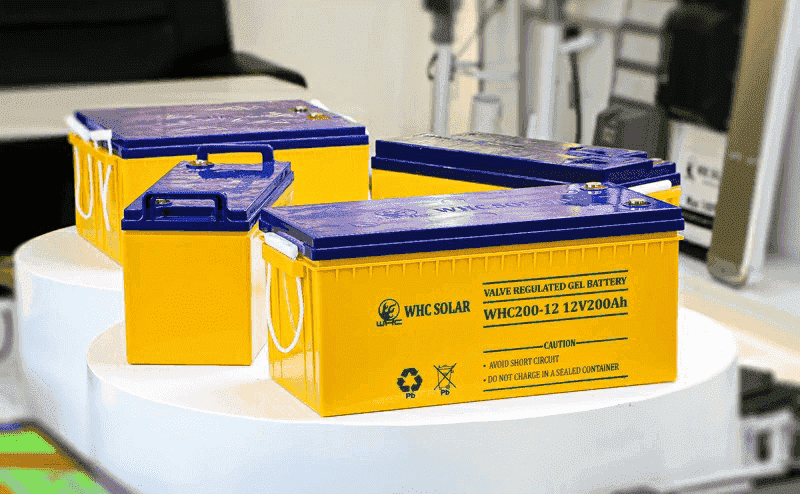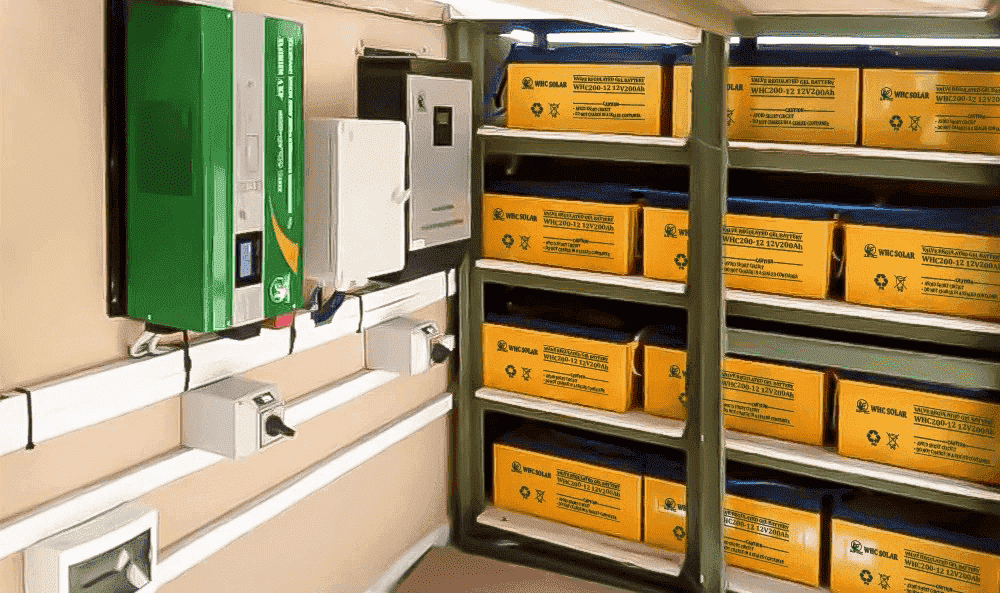Cuando se trata de alimentar electrodomésticos de forma sostenible, baterias de gel solares son grandes alternativas. Hay muchas preguntas que me vienen a la mente como, “¿Qué es una batería de gel?? ¿Esta nueva tecnología de baterías sería suficiente para los diseños de mi sistema solar?? ¿Cómo elijo un fabricante de baterías de gel?"
Las baterías de gel son adecuadas para sistemas solares aislados de la red. Pueden funcionar como fuente de energía de respaldo para los ya instalados. paneles solares o sistema de energía solar. En este articulo, Daremos respuesta a algunas preguntas difíciles y te explicaremos todo lo que necesitas saber sobre la batería de gel solar., sus pros y sus contras, y compararlo con la tecnología de batería AGM.
¿Qué es una batería de gel??

Las baterías de gel son baterías que utilizan un electrolito similar a un gel.. El electrolito en forma de gel se obtiene mezclando ácido sulfúrico con sílice para permitir que se endurezca y se vuelva más viscoso que el líquido.. Las baterías de gel están diseñadas adecuadamente para resolver algunos problemas que podría encontrar al usar las populares baterías húmedas de plomo-ácido.. Aunque las baterías de gel comparten muchas similitudes con las baterías de plomo-ácido en términos de diseño y principios de funcionamiento., Se diferencian en sus componentes.. Mientras que una batería de plomo-ácido utiliza una solución de electrolito líquido, una batería de gel utiliza un electrolito más viscoso. El electrolito consiste en ácido sulfúrico mezclado con sílice como endurecedor.. Porque la sílice le da a la solución una sensación de gel., Las baterías de gel solar no emiten tantos humos como las baterías tradicionales..
El bateria de gel solar También es muy ligero y estable.. Como resultado de esto, son fáciles de instalar. También tienen una vida útil más larga y pueden mantener su carga por más tiempo que las baterías normales.. Estas características también han llevado al uso generalizado de baterias de gel para paneles solares. Su durabilidad y otras propiedades favorables los han convertido en la opción preferida en diversas aplicaciones, como dispositivos médicos de movilidad., dispositivos electronicos, equipo marino, y dispositivos que funcionan con energía solar.
¿Cómo funciona una batería de gel??
Una batería de gel, a veces llamada batería de celda de gel., es un plomo-ácido regulado por válvula (VLRA) batería. Los componentes de la batería son electrolitos en forma de gel y ácido sulfúrico., que se combinan con vapores de sílice. La presencia de sílice en la batería de gel provoca que se produzca una reacción química., dando como resultado la formación de una sustancia estacionaria parecida a un gel de la que la batería recibe su nombre.
Las baterías de gel se fabrican con placas positivas planas o tubulares.. Estas baterías utilizan la masa de gel inmóvil para utilizar electrolitos y ácido sulfúrico de la misma manera que una batería de plomo-ácido típica.. Las baterías de gel tienen un sistema unidireccional de válvulas abiertas que permiten que los gases del interior se recombinen con el agua.. Esto los hace requerir cero mantenimiento, ya que no es necesario verificar si hay nivel de agua en la parte superior.
Estas baterías son muy versátiles y producen muy pocos gases o humos.. Como resultado, Se pueden instalar de forma segura en lugares con ventilación limitada., como casas residenciales.
Ventajas de las Baterías de Gel Solar
Varios Beneficios de las baterías de gel. convertirlos en una opción cada vez más popular para los sistemas de energía solar. ellos incluyen:
- Libre de mantenimiento: Las baterías de gel solar están compuestas de una sustancia similar a un gel en lugar de líquido, por lo que requieren poco o ningún mantenimiento para funcionar bien.
- A prueba de derrames sin temor a fugas: Las baterías de celdas húmedas tienen una alta posibilidad de fugas a pesar de que tienen carcasas de plástico.. En el caso de las baterías solares tipo gel, sucede lo contrario. Gracias a la sustancia similar a un gel y a la válvula de eliminación de presión de estas baterías, no hay riesgo de fuga.
- Diseño e instalación flexibles: Las baterías de gel son a prueba de derrames, lo que permite su uso tanto en posición horizontal como vertical. Esta característica es increíblemente beneficiosa para una amplia gama de aplicaciones de baterías..
- Aplicaciones de ciclo profundo: Las baterías de gel son la opción ideal para aplicaciones de ciclo profundo porque tienen ciclos de vida de 500 a 5000 ciclos. Esto significa que se pueden descargar más y recargar como si fueran nuevos..
- Construcción robusta y resistente: Estas baterías tienen plásticos no conductores en su exterior., haciéndolos resistentes a fuertes vibraciones, choques, y otros impactos sustanciales. Esta característica los hace adecuados para vehículos de cuatro ruedas..
- Riesgo mínimo: Con baterías de gel, hay menos riesgo de derrame. No hay riesgo de quemaduras por ácido sulfúrico ni daños al equipo.. A diferencia de las baterías de plomo-ácido, donde usted puede enfrentar peligros de limpieza en caso de derrame, no tienes que preocuparte por derrames. Además de esto, hay menos posibilidades de corrosión, y las baterías de gel se utilizan comúnmente con equipos electrónicos sensibles.
- Mejor tolerancia al calor: Además de ser más livianas que las baterías normales, Las baterías de gel tienen una alta tolerancia al calor.. Se pueden utilizar adecuadamente en lugares con sistemas de ventilación limitados..
Desventajas de las baterías de gel solar
Aunque las baterías de gel solar tienen una serie de beneficios, tienen ciertas desventajas. La principal desventaja de estas baterías se ve en la precio de la batería solar de gel. Las baterías de gel solar suelen ser más caras que otros tipos de baterías.
La lentitud de carga de las baterías de gel también es otra preocupación. En comparación con las variantes tradicionales., Estas baterías tardan bastante en cargarse por completo.. Otra cosa es que el cargador debe retirarse inmediatamente después de que se complete el proceso de carga para evitar el riesgo de daños irreversibles.. Porque estas baterías tienen un electrolito en gel., sobrecargarlos puede causar huecos en el electrolito y, como consecuencia, reducir la vida útil de la batería. Incluso puede ser necesario utilizar reguladores especiales mientras se cargan estos tipos de baterías..
El almacenamiento frecuente de baterías de gel en áreas calientes puede afectar negativamente al gel., haciendo que se endurezca y se aleje de las placas. Las baterías entonces no durarían tanto como deberían..
¿Qué es mejor?: Batería AGM o Gel

El debate sobre las baterías AGM versus las de gel es muy común, Todos quieren saber qué batería es realmente la mejor opción para una variedad de aplicaciones.. Ya que tienen ciertas similitudes., Mucha gente tiende a pensar que la batería AGM es una opción viable.. Varias cualidades hacen que las baterías de gel destaquen frente a las baterías AGM.
Para responder a la pregunta de cuál es mejor, Haremos comparaciones a continuación entre ambas baterías para ayudarlo a tomar una decisión informada sobre el tipo de batería ideal para usted..
¿Qué significa la batería AGM??
El batería AGM, abreviatura de tapete de vidrio absorbente, es un tipo de batería VLRA con tecnología de batería sellada. en la bateria, Los electrolitos están confinados en finas esteras de fibra de vidrio con placas de plomo en ambos lados.. La estera de vidrio ultrafina, también llamado separador AGM, Absorbe los electrolitos para que no inunden libremente las placas como en las baterías inundadas normales.. Las baterías AGM funcionan de manera óptima porque la lámina de vidrio proporciona una gran superficie para la reacción entre el electrolito y las placas de plomo.. La válvula ayuda a regular la presión dentro de la batería., protegiendo su integridad estructural. Las baterías AGM son muy útiles en muchas aplicaciones de ciclo profundo, como marino, aviación, y sistemas de energía fuera de la red.
Ventajas de la batería AGM:
- Son ligeros y duraderos, con la capacidad de resistir la congelación. Aunque no generarán energía en temperaturas más frías., las placas no se agrietarán y permanecerán intactas.
- Tienen una vida útil más larga que las baterías tradicionales.. Cuando se mantiene adecuadamente, pueden durar más que las baterías selladas de plomo-ácido.
- Tienen menor resistencia interna., que permite una rápida generación de energía, especialmente en baterías de automóviles que necesitan ráfagas rápidas de energía para que el motor arranque.
- Las baterías AGM son resistentes a golpes y vibraciones.. Las esteras de vidrio saturadas de electrolito actúan como amortiguador., y con los platos bien apretados, el efecto de impactos repentinos se reduce al mínimo. Esto es ventajoso en aviones militares..
- Son a prueba de derrames y pueden usarse en lugares con ventilación limitada porque tienen salidas mínimas de gas.. También son baterías sin mantenimiento..
- Tienen una tasa de recarga rápida y una mayor profundidad de descarga de 80% haciéndolos ideales para aplicaciones de ciclo profundo como sistemas UPS, carritos de golf, vehículos recreativos, y vehículos marinos.
Contras de la batería AGM:
Las baterías AGM tienen algunos inconvenientes, al igual que otros tipos de baterías. La principal desventaja de estas baterías es que son relativamente caras.. Su fabricación cuesta más que las baterías convencionales, haciéndolos más caros.
Estas baterías también son propensas a dañarse por sobrecarga.. Ser sensible a sobrecargas y altos voltajes., su vida útil y rendimiento- puede verse afectado negativamente. Lo mejor sería utilizar los cargadores y reguladores especificados para las baterías para una longevidad óptima..
Batería de gel AGM VS.
El Batería AGM versus batería de gel La comparación es necesaria porque tienen similitudes que algunas personas pueden encontrar confusas.. Entonces, ¿qué los hace diferentes??
| Característica | Baterías de gel | baterías AGM |
| Costo | Son más caros porque cuestan más fabricarlos. | menos costoso |
| Cargar | Puede dañarse si se sobrecarga, cargado incorrectamente, o usado con un cargador cónico. | Se carga rápidamente y es capaz de mantener bien la carga |
| Resistencia interna | Tienen mayor resistencia interna y no funcionan bien con aparatos que necesitan corrientes elevadas.. No se pueden utilizar como baterías de arranque.. | Baja resistencia interna al ácido y puede usarse como baterías de arranque.. |
| Estructura interna | Las baterías de gel tienen placas más delgadas, y el electrolito está suspendido en el caso de una batería de gel. | Internamente, El electrolito está suspendido por una estera de fibra de vidrio con placas más gruesas para evitar fugas.. |
| Fuga térmica | Mejor tolerancia al calor y más adecuado para altas temperaturas., funcionando bien en áreas con mala ventilación. | Conducen mal el calor porque la estera de vidrio actúa como aislante y se adapta mejor a temperaturas más frías.. |
| Esperanza de vida | Se puede descargar hasta 90% y tendrá un mayor rendimiento y vida útil si se cuida bien. | Aunque las baterías AGM pueden durar años, la descarga frecuente acorta significativamente el ciclo de vida. |
Conclusión
Las baterías de gel son una inversión que vale la pena si se cuidan adecuadamente. Tienen tasas de rendimiento máximas a lo largo de su vida útil cuando se usan correctamente. Aunque los precios de las baterías de gel solar son más altos que los de las baterías de celda húmeda de tamaño similar, Tienen mejor rendimiento en varias configuraciones.. Junto con otras características únicas, Estas baterías son más seguras y confiables que las otras alternativas..
Aún, tratando de decidir cuál es la opción de batería correcta? WHC SOLAR ofrece soluciones de baterías de gel para todas las aplicaciones únicas. Un reconocido fabricante de productos solares., WHC SOLAR tiene a la venta baterías de gel solar todo en uno. Visítenos en línea o llámanos hoy para realizar consultas sobre las mejores baterías de gel para aplicaciones solares.
